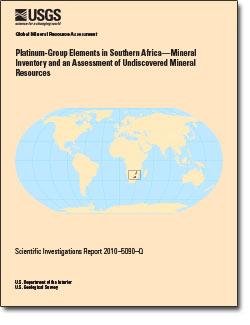 Abstract
Abstract
The platinum-group elements, platinum, palladium, rhodium, ruthenium, iridium, and osmium, possess unique physical and chemical characteristics that make them indispensable to modern technology and industry. However, mineral deposits that are the main sources of these elements occur only in three countries in the world, raising concerns about potential disruption in mineral supply. Using information in the public domain, mineral resource and reserve information has been compiled for mafic and ultramafic rocks in South Africa and Zimbabwe that host most of the world’s platinum-group element resources.
As of 2012, exploration and mining companies have delineated more than 20 billion metric tons of mineralized rock containing 42,000 metric tons of platinum, 29,000 metric tons of palladium, and 5,200 metric tons of rhodium, primarily in mafic and ultramafic intrusions of the Bushveld Complex and the Great Dyke, in southern Africa. Additional mineralized rock is likely to occur in extensions to the well-explored and characterized volumes of mineralized rock. Underexplored extensions of stratabound platinum-group element (PGE) deposits in the Bushveld Complex in South Africa may contain 65,000 metric tons of platinum, palladium, and rhodium to a depth of 3 km. Rocks enriched in PGE, which occur near the contact of the Bushveld Complex with older Transvaal Supergroup sedimentary rocks, may contain 1,100 metric tons of platinum and 1,370 metric tons of palladium (mean estimate to a depth of 1 km). A stratabound platinum-group element deposit in the Great Dyke in Zimbabwe may contain 6,900 metric tons of undiscovered platinum, palladium, and rhodium. By comparison, the global net demand for PGE in 2012 was approximately 460 metric tons. Since the 1920s, mining has recovered 7,200 and 107 metric tons of platinum-group elements from the Bushveld Complex and the Great Dyke, respectively.
The large layered intrusions in southern Africa—the Bushveld Complex and the Great Dyke—are now and will continue to be a major source of the world’s supply of PGE. Mining will not deplete the identified mineral resources and reserves or potential undiscovered mineral resources for many decades; however, in the near-term, PGE supply could be affected by social, environmental, political, and economic factors.